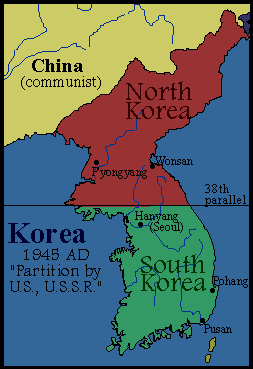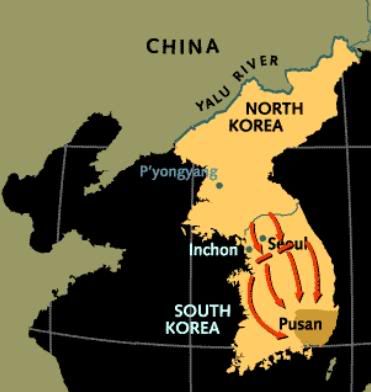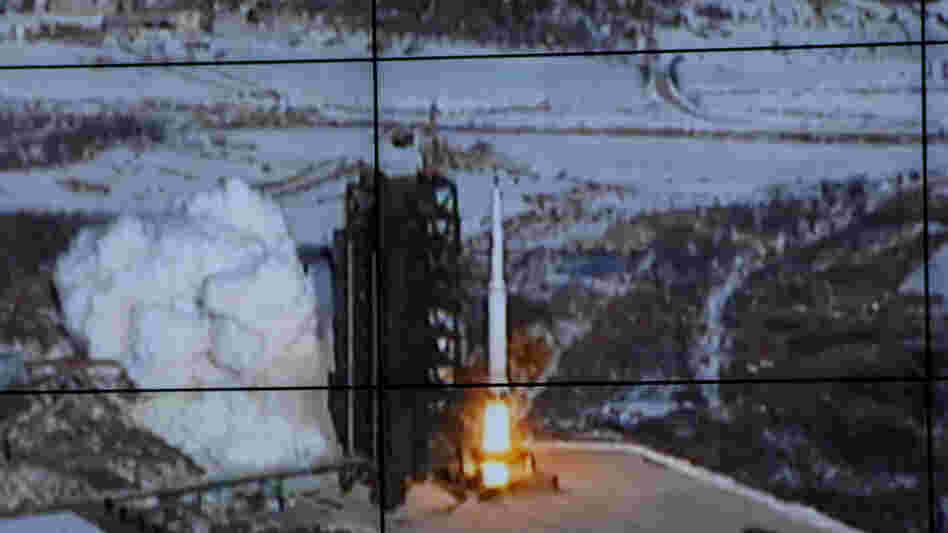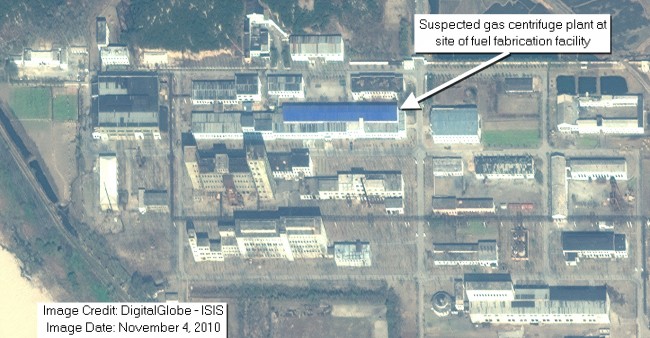"Our nuclear strength is a reliable war deterrent and a guarantee to protect our sovereignty."
- Kim Jong-Un
North Korea, more correctly the
Democratic People’s Republic of Korea or DPRK, has once again come into the
news recently. Kim Jong-il, the “Dear Leader” of the DPRK died of a heart
attack on December 17, 2011. He, in the preceding years, had set his third son
Kim Jong-un as the clear successor to his position. The world has waited and
watched to see how the new Kim will lead his isolated nation. Even pop culture
world weighed in:
Now, under Kim Jong-Un, the 59 year
long armistice in Korea is over and the saber-rattling has reached the tipping
point. What is to come, and how did we get here?
Korea is a 600-mile (966km)
peninsula jutting out from China and Russia. North Korea occupies the area, slightly
smaller than Pennsylvania, north of the 38th parallel. The country is almost
completely covered by a series of north-south mountain ranges separated by
narrow valleys. The Yalu River forms part of the northern border with China,
and a DMZ stretches roughly along the 38th parallel forming the
Southern border.
The ancient history of the Korean
peninsula can be traced to the Neolithic Age. The first agriculturally based
settlements appeared around 6000 B.C. Throughout its history, Korea has been
invaded, influenced, and fought over by its larger neighbors. Korea was alternatively a vassal state of China and Japan. When Western
powers focused "gunboat" diplomacy on Korea in the mid-19th century,
Korea's rulers adopted a closed-door policy, earning Korea the title of
"Hermit Kingdom." Chinese
influence dominated until the Sino-Japanese War of 1894–1895. Following Japan's
victory, Korea was granted “independence.” By 1910, Korea had been annexed by
Japan, which developed the country but never won over the Korean nationalists,
who continued to agitate for independence.
Hoping to unify the Koreas under a
single Communist government, the North launched a surprise invasion of South
Korea on June 25, 1950. In the following days, the UN Security Council
condemned the attack and demanded an immediate withdrawal. The United
Nations, in accordance with the terms of its Charter, engaged in its first
collective action and established the UN Command (UNC), to which 16 member
nations sent troops and assistance.
Next
to South Korea, the United States contributed the largest contingent of forces
to this international effort.
The North Korean invaders swiftly
seized Seoul and surrounded the allied forces in the peninsula's southeast
corner near Pusan. In a desperate bid to reverse the military situation, UN
Commander Gen. Douglas MacArthur ordered an amphibious landing at Inchon on
Sept. 15 and routed the North Korean army. MacArthur's forces pushed north
across the 38th parallel, approaching the Yalu River.
Prompted by this successful
counteroffensive, Mao Tse-Tsung’s China entered the war, after large
numbers of Chinese "People's Volunteers" intervened to assist the
North, forcing the UN troops into a
headlong retreat. Seoul was lost again, but later regained. Ultimately, the war
stabilized near the 38th parallel in 1951 but dragged on for two years while
negotiations took place. An armistice was achieved on July 27, 1953.
On
that date, at Panmunjom, the military commanders of the North Korean People's
Army, the Chinese People's Volunteers, and the UNC signed an armistice
agreement. Neither the United States nor South Korea is a signatory to the
armistice per se, although both adhere to it through the UNC. No comprehensive
peace agreement has replaced the 1953 armistice pact; thus, a condition of
belligerency, or war, never ceased to exist. In 2013, the DPRK nullified the armistice
and war, in spirit but not form, has returned.
In September 1990, the first of eight prime minister-level meetings between North Korean and South Korean officials took place in Seoul. The prime ministerial talks resulted in two major agreements: the Agreement on Reconciliation, Nonaggression, Exchanges, and Cooperation (the "Basic Agreement") and the Declaration on the Denuclearization of the Korean Peninsula (the "Joint Declaration").
The Basic Agreement, signed on December 13, 1991, called for reconciliation and nonaggression and established four joint commissions. These commissions (on reconciliation, military affairs, economic exchanges and cooperation, and social and cultural exchange) were to work out the specifics for implementing the basic agreement. Subcommittees to examine specific issues were created, and liaison offices were established in Panmunjom, but in the fall of 1992 the process came to a halt because of rising tension over North Korea's nuclear program.
The Joint Declaration on denuclearization was signed on December 31, 1991. It forbade both sides to test, manufacture, produce, receive, possess, store, deploy, or use nuclear weapons and forbade the possession of nuclear reprocessing and uranium enrichment facilities. A procedure for inter-Korean inspection was to be organized and a North-South Joint Nuclear Control Commission (JNCC) was mandated to verify the denuclearization of the peninsula.
On January 30, 1992, the D.P.R.K. finally signed a nuclear safeguards agreement with the IAEA, as it had pledged to do in 1985 when becoming party to the nuclear Non-Proliferation Treaty. This safeguards agreement allowed IAEA inspections to begin in June 1992. In March 1992, the JNCC was established in accordance with the Joint Declaration, but subsequent meetings failed to reach agreement on the main issue of establishing a bilateral inspection regime.
Kim Il Sung's death on July 8, 1994,
introduced a period of uncertainty, as his son, Kim Jong Il, assumed the mantle
of leadership. Kim Jong Il continued his father’s vacillation between open
talks and saber-rattling. Kim has regularly used threats and hostile acts to
try to wring aid from the international community, but it was difficult to
decipher how he expected to accomplish his aims, economic aid and a safeguard
against U.S. attack, through such brinkmanship.
In Jan. 2002, President Bush
described North Korea as part of an “axis of evil.” Such open hostility marked
a dramatic shift in U.S. policy toward North Korea from the Clinton
administration's policy of engagement. Meetings between officials from the
U.S., North Korea, China, Russia, South Korea, and Japan in 2003, 2004, and
2005 ended in deadlock.
In July 2006, North Korea launched
seven missiles: the long-range Taepodong-2 missile (which failed) and six
medium-range weapons. It was North Korea's first major weapons test in eight
years. North Korea again sparked international outrage in October, when it
tested a nuclear weapon. President Bush called the test a “threat to
international peace and security” and called for sanctions against North Korea.
For the first time in 56 years,
trains passed between North and South Korea in May 2007. While the event was
mostly symbolic, it was, at the time, considered an important step toward
reconciliation. In Oct. 2007, Kim Jong Il and South Korean president Roh Moo
Hyun met for their second ever inter-Korean summit. The leaders forged a deal
to work together on several economic projects and agreed to move toward signing
a treaty that would formally end the Korean War.
Two more weapons tests followed: an
underground nuclear test and a short-range missile test. The nuclear test was
North Korea's second. International monitoring organizations said that it was
more powerful than the previous blast, three years ago.
In March 2010, the South Korean
warship Cheonan was sunk in an area of the Yellow Sea that's in dispute with
North Korea. Forty-six sailors were killed. Conditions further deteriorated in
November when North Korea attacked Yeonpyeong, a small island in South Korea
located near the maritime border between the North and South, killing two
soldiers and two civilians and leveling entire neighborhoods. Many speculated
that North Korea's provocative actions were intended to boost the credibility
and prominence of Kim Jong-Un, Kim Jong-Il's likely successor.
At the Korean Workers Party
conference in September 2010, President Kim promoted his third son, Kim Jong-Un,
to the rank of four-star general, gave him a seat on the party's Central
Committee, and appointed him as vice chairman the party's military commission,
paving the way for him to take over as president. Little is known about Un, who
is in his late 20s, other than he attended a private boarding school in
Switzerland.
Kim Jong-Il died of a heart attack
on December 17, 2011. The "Dear Leader" had been in power since 1994
and presided over his isolated country through a devastating flood that claimed
between 2 million and 3 million citizens in the 1990s and left the economy in
shambles. He taunted the U.S. and the international community with his dogged
pursuit of nuclear weapons. Kim Jong-Un succeeded his father and was given the
title "Great Successor." Kim's death and Kim Jong-Un's ascendance put
the world on high alert as a power struggle or an attempt by Kim Jong-Un to
prove his mettle could create a dangerous situation in an already unstable
country that has long harbored nuclear ambitions.
There was a sense of relief, as well
as caution, in late February when North Korea announced it was suspending
uranium enrichment at its processing facility in Yongbyon and halting tests of
weapons and long-range missiles. In exchange, the U.S. said it would resume
food aid to the impoverished nation. Observers speculated that Kim Jong-Un
might be attempting to win the favor of North Koreans with the infusion of food
or beginning to chart a new path in foreign relations. Nevertheless, North
Korea has made such promises in the past only to later renege.
On April 12, the country attempted
to launch a rocket carrying a satellite into orbit, but the rocket blew up
seconds after the launch. The failure was an embarrassment to Kim Jong-Un, who
had just been honored with two new titles: leader of the national defense
commission, the nation's most powerful government agency; and first secretary
of the Workers' Party of Korea. The launch coincided with the celebration of
the 100th birthday of North Korea's founder and Kim Jong-un's grandfather, Kim
Il-sung. In response to the attempt, the U.S. suspended 240,000 tons of food
aid to North Korea.
North Korea's next attempt to put a
satellite into orbit was not a failure. The successful launch of the rocket on
December 12 indicated that the country was inching closer toward developing the
expertise to build an intercontinental ballistic missile. It also boosted Kim
Jong-un's credibility both domestically and internationally, illustrating his
seriousness in advancing the country's military capabilities. The launch took
the world by surprise and was followed by another round of UN sanctions that
were supported by China, which normally opposes such measures. Less than a week
later, astronomers reported that the satellite was spinning in orbit, a sign
that it had failed post-launch.
In Feb. 2013, North Korea said it
had detonated a third nuclear bomb. World leaders, scientists, and intelligence
officials rushed to determine if the bomb was fueled by uranium or plutonium.
Plutonium was used in earlier tests in 2006 and 2009, and officials said if
uranium powered the bomb then it was a signal that North Korea was on its way
to developing a larger and more powerful arsenal. The explosion was small
compared to those detonated by China in the 1960s and the U.S. in 1945 but
larger than North Korea's previous tests. In response to the test, the UN
Security Council unanimously passed another round of strict sanctions against
North Korea. In a first, China was involved in drafting the sanctions. The
sanctions came shortly after the U.S. and South Korea began annual military
drills near the north-south border. Reacting to the sanctions and the
exercises, President Kim promised to launch “a pre-emptive nuclear strike”
against the U.S. and South Korea and said he had voided the 1953 armistice that
ended the war between North and South Korea. Kim's threats were mostly dismissed
as bluster but were nevertheless the most menacing in years by any leader. He
continued his bellicose tone in March and shut down not only Red Cross hotlines
between North and South Korea but also military hotlines. At a rare plenary
meeting of the Central Committee, Kim said North Korea would continue to
develop its nuclear weapons program despite sanctions, saying the weapons
"“are neither a political bargaining chip nor a thing for economic
dealings."
In March, the US responded to the
growing threat from North Korea by continuing the military drills with South
Korea, deploying F-22 stealth fighter jets and B-2 and B-52 bombers to the
region in a show of its military strength. The U.S. also increased the number
of ground-based ballistic missile interceptors in California and Alaska.
The question then stands, what is to
happen now?
I think it would be impossible for
anyone to predict the behavior of any leader of North Korea. Although the
leadership basks in relative wealth and has travelled beyond its borders (Un was
educated in Switzerland), it has been the nation’s policy to be unpredictable.
Un’s grandfather Kim Il-Sung fluctuated between Soviet and Chinese spheres,
playing each against the other for his own benefit. Kim Jong-Il made the same
policy, now bouncing between an active member of the international community
and being an isolated, unknown entity. It seems that Kim Jong-Un has learned
those lessons of his father and repeated them.
Reports from the DPRK read straight
out of 1984. The government rewrites history as it sees fit and the people,
victims of the leading family’s personality cult, follow in lock step. Any divisiveness
is met with purges. Millions gather to disparage the West and raise up the
Great Successor as a demigod.
I have
previously mentioned a personal conversation that I had with former UN weapons
inspector Scott Ritter. In that conversation, he stressed that North Korea was
far greater a threat than Iraq. The DPRK is a known WMD proliferator, or was
under Jong-Il, and their military development is the number one priority. In
2010, Siegfried
Hecker, a Stanford professor and former director of the Los Alamos National
Laboratory, said that during a visit to North Korea, officials gave him a tour
of a uranium-enrichment facility that contained 2,000 centrifuges that can be
converted to produce nuclear weapons. Hecker described the facility as
sophisticated and "ultra modern."
But let’s separate fact from fiction. Question
number one: does the DPRK have nuclear weapons? My study of the subject
suggests that this is a fact. Although their first weapon, likely a plutonium
bomb, was small and relatively unsuccessful; it has been theorized that the
more recent bombs were uranium, had higher yields, and, although less powerful
than Hiroshima, is still a powerful weapon. The important thing to keep in
mind, when it comes to using these weapons, is size. Below are two pictures.
The first is a picture of the Trinity Test device, America’s first nuclear
weapon. The second is a picture of “Fat Man,” one of the United State’s first
atomic weapons. The scale is important here. These weapons are much larger than
a man and exponentially heavier. The DPRK has no ability to deliver a weapon of
this type, as they possess few, if any, heavy bombers and their rockets don’t
have the payload capacity.
Question number two: Can the DPRK attack the US?
This is where the issue gets cloudy. It is clear that North Korean rocket
technology has greatly advanced. Their short, medium, and intermediate range
rockets have had multiple successive tests, but it’s unclear whether their
targeting programs would allow for accurate use of the weapons. Typically, they
program the weapons to splash down in the Pacific. In any event, their rockets
could reach South Korea, Japan, Taiwan, the Philippines, and other US allies in
East and Southeast Asia, and the Pacific. They could also attach US forces,
including permanent bases, in these countries. Arguably, the medium range
rockets may even be able to reach Guam or other US Pacific territories, and
maybe even the Hawaiian Islands. However, reports from their long range rocket
tests have been less successful. They have had multiple failures and even later
examination of the “success” of launching a satellite shows trajectory problems
in the crucial third stage. The likelihood that they now possess accurate ICBM
technology is slim to none. Assuming they could even reach the continental US,
its unlikely that the targeting would be accurate, and they certainly could not
carry the payload of their current WMD size. (Much like other technology,
nuclear weapons can get smaller and lighter as the program progresses in
success.)
Question number three: Would the US go to war in South
Korea if North Korea doesn’t attack us? The short answer is yes. The Mutual Defense Treaty Between the United States and the Republic of
Korea, which was signed October 1, 1953 and later ratified by both countries
states, in pertinent part, ARTICLE III, Each Party recognizes that an armed attack in the Pacific
area on either of the Parties in territories now under their respective
administrative control, or hereafter recognized by one of the Parties as
lawfully brought under the administrative control of the other, would be
dangerous to its own peace and safety and declares that it would act to meet
the common danger in accordance with its constitutional processes. Further, it
states, ARTICLE IV, The Republic of Korea grants, and the United States of
America accepts, the right to dispose United States land, air and sea forces in
and about the territory of the Republic of Korea as determined by mutual
agreement. (Read the entire agreement here.) Basically,
the United States has agreed to come to the aid of South Korea is unjustly
attacked by any other force. The one caveat is the clause “in accordance with
its constitutional processes.” This means, for the US, Congress would have to
approve of the use of force. See my previous post on Iraq to how difficult that
may be.
Question
number four: Would the DPRK be able to continue a war against the US and
allies? This is another tricky question. Technically, the DPRK has the fourth
largest armed forces in the world. However, a lesson can be shown by the
previous fourth largest military: Iraq. Although North Korea has a large army, in
terms of soldiers and machines, the majority of their troops are likely to be
malnourished. When compared, they would not be on par with the average American
soldier. They are using a mixture of technology from WWII through, possibly,
even modern weaponry. They do have something that perhaps Iraq did not. They
were raised in the juche and personality cult of North Korea. The military of
Iraq was a mixture of ethnicities and religions. The DPRK armed forces are
homogenous in ethnicity and religion. They are likely to fight to the death for
the Great Successor. You must imagine their forces to be, in passion, far more
like those of the Japanese Empire than any other previous enemy of the US. While
the US, and allies, were able to roll through the Iraq military, and take
thousands of willing prisoners along the way; there would likely be far fewer
prisoners and more bloodshed to make progress. Moreover, in the scenario where
the DPRK is the aggressor, the US would have no staging ground as they did in
Kuwait and Saudi Arabia before the Iraq invasion. It would be necessary to
throw any available troops into the fight, almost haphazardly. Under the worst of
circumstances, an amphibious and air assault may be necessary to liberate South
Korea.
I would be
happy to answer any other questions people have, please just post in the
comments below. To summarize, here are my thoughts. It is almost North Korean
policy to “rattle their sabers.” Like a petulant child, the leaders of the DPRK
think that the only way to get attention and respect is to intimate their
impressive military and nuclear capability should be feared. In the coming
months, I will post about the dangers of our current nuclear policy and how it
encourages proliferation, rather than limiting it. However, I don’t think that
there should be any big concern about an attack from North Korea on either US
or South Korean forces. North Korea gains nothing from such an action, and
risks complete annihilation. However, they can gain something from making threats
and then backing off. Kim Jong-Un is a new leaders, and he needs to consolidate
power in the face of continuing food shortages and overall poverty. This is the
way he has chosen to do it. Express strength, make threats, and hope to bring
everyone else to the table; only to do it again later.
I must stress that North Korea remains a
potent force and pre-emptive action is not only unnecessary, but looking to
history, would be more detrimental than good. Hopefully, our leaders have
learned that lesson and will use restraint with DPRK threats. However, we must
also be wary of rewarding bad behavior and using appeasement to diffuse
conflict. History also shows that this does more harm than good. It is
certainly a tight line to walk, and hopefully the US and UN will do so.
© Robert
Cheek, 2013



















No comments:
Post a Comment